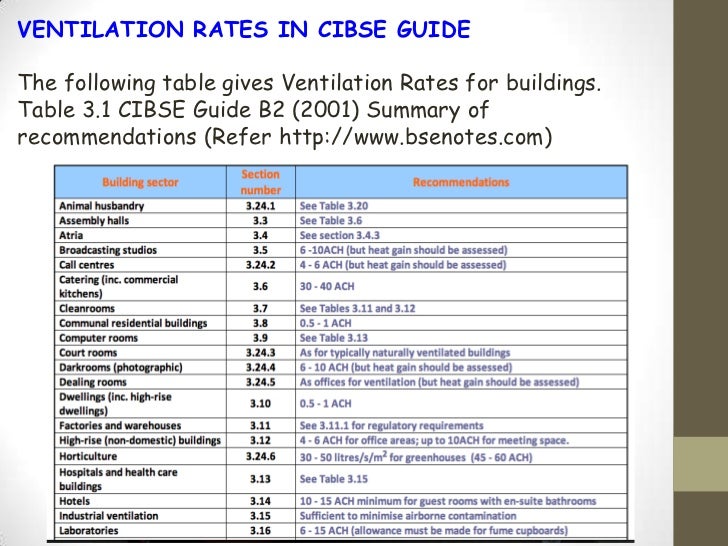Cibse Guide To Ventilation

Cibse Guide For Ventilation
CIBSE Guide B Ventilation, Air Conditioning and Acoustics Revision of CIBSE Guide B Sections 2, 3 and 12 Ventilation, Air Conditioning and Acoustics Why are we doing this? Guides are the authoritative source of guidance for the design of building services in the UK, being used by over 80% of UK designers. The most recent revision of Guide B took place in 1986. Since then innovative low energy ventilation and cooling systems have been developed which are now available to the engineer. There have also been improvements in the design and operation of existing traditional systems. Work is now underway to revise Sections B2 and B3 to ensure that professional design standards for these systems are produced in line with current best practice thinking to help to minimise energy use and CO 2 emissions.
Displacement ventilation T8 T Redefine your comfort zone™ www.titus-hvac.com APPLICATION GUIDE APPLICATION GUIDE Displacement Ventilation Design &.
Also under revision is the related acoustic guidance given in Guide B12. How can you help? CIBSE Guides represent the concensus view of the profession on what represents current good practice. The initial phases of the project involve reviewing which new systems need to be incorporated and also where the information on existing systems needs revision. Input is currently being sought from the profession to guide this process. In future inputs will also be invited to support the production of the new text and to review drafts. Your involvement in this process will ensure that your interests are taken into account in the guidance.
Cibse Guide B2/B3: Ventilation and Air Conditioning [Chartered Institute of Building Services Engineers] on Amazon.com. *FREE* shipping on qualifying offers. By Paul Woods and Chartered Institution of Building Services Engineers. Out of Print--Limited Availability. CIBSE Guide B2: Ventilation and Ductwork 2016 Jun 27.
Possible new systems. Low energy systems being considered for incorporation include:. evaporative cooling. desiccant cooling. ground coupled systems. night cooling. chilled ceilings and beams.

displacement ventilation. aquifers. slab cooling with air. slab cooling with water. Who to contact For further information contact the CIBSE project manager: Dr Hywel Davies, Hywel Davies Consultancy, 2 The Furlong, Bedford, MK41 8EE, Tel & Fax: 69, e-mail: Organisations currently involved in the project include: DETR, CIBSE, BRE, Oscar Faber, AMEC Design & Management, Dept of Education & Employment, Biddle Air Systems, BRECSU, BSRIA, Buro Happold, BWP, Cardiff University, FC Foreman, HVCA, Max Fordham, Museums & Galleries Commission, Ove Arup & Partners, Oxford Brookes University, Willan Building Services.
Back to the.
Ventilation Overview The design of the hotel ventilation system is vital to the overall comfort of the occupants who will inhabit the building. The system will bring fresh air with more oxygen and less carbon dioxide at the same time as remove the hazardous chemicals that would be present from the chemicals used in the swimming pool or the dangerous volatile organic compounds which are present in any dwelling to improve the air quality of the indoor spaces. Ventilation is the process of continual change of air to a room and there are two means by which to move this air. The first is by Mechanical Ventilation which draws air from the exterior of the building through ducting and fans to the space, the ‘old’ air is extracted from another area within the space to be released to the atmosphere. The other option is natural ventilation, which uses passive processes and makes use of the local micro climate to facilitate the air movement within the building. Both systems will be considered for use within the hotel. The balance between low energy use and the comfort levels created is a conflict which will be encountered within the ventilation design strategies.
Whilst a low energy design is advantageous, within a hotel environment, occupants expect very high levels of comfort and are paying to be within this atmosphere. The comfort therefore will take greater priority, as the hotel will only be economically viable if it can attract visitors and keep them satisfied. Bearing both comfort and energy consumption in mind the two main ways of ventilating the hotel are outlined below with the advantages of integrating the systems.
Mechanical Ventilation Advantages. Fresh air can be supplied with ease deeper within the building. Not dependant on outdoor weather conditions. Air flow rate is easily controllable. Air can be directed to allow the output to be passed through a passive heat exchanger Natural Ventilation Advantages. No noise produced in the operation of the system.
Completely passive so no energy required. Minimal maintenance required. Decreased capital costs Due to the advantages of both systems being highly desirable a ‘hybrid’ ventilation system for the hotel will be used, where as much of the system as possible will be made up from Natural ventilation to save in energy consumption and where there is a shortfall in air change rates, Mechanical Ventilation will be implemented. As much information as possible was gained about the required levels of ventilation for the various areas of the hotel from the CIBSE guide B in order to design a system to meet the hotels requirements.